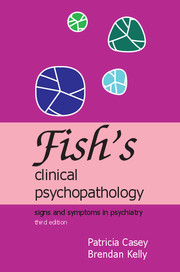Book contents
- Frontmatter
- Contents
- The authors
- Preface
- 1 Classification of psychiatric disorders
- 2 Disorders of perception
- 3 Disorders of thought and speech
- 4 Disorders of memory
- 5 Disorders of emotion
- 6 Disorders of the experience of self
- 7 Disorders of consciousness
- 8 Motor disorders
- 9 Personality disorders
- Appendix I Psychiatric syndromes
- Appendix II Defences and distortions
- Index
Appendix I - Psychiatric syndromes
Published online by Cambridge University Press: 15 February 2018
- Frontmatter
- Contents
- The authors
- Preface
- 1 Classification of psychiatric disorders
- 2 Disorders of perception
- 3 Disorders of thought and speech
- 4 Disorders of memory
- 5 Disorders of emotion
- 6 Disorders of the experience of self
- 7 Disorders of consciousness
- 8 Motor disorders
- 9 Personality disorders
- Appendix I Psychiatric syndromes
- Appendix II Defences and distortions
- Index
Summary
Blocq's disease Also known as astasia-abasia. This is the inability to walk or stand in a normal manner. The gait is bizarre and is not suggestive of any organic lesion. It is often characterised by swaying and almost falling, with recovery at the last moment. It is a conversion symptom (dissociative motor disorder in ICD–10 and conversion disorder in DSM–IV).
Briquet's syndrome Now called somatisation disorder, Briquet's syndrome is a condition in which there are multiple physical complaints, in several systems, for which no physical cause is found. It begins usually before the age of 30 years, runs a chronic course and is associated with frequent medical contact. The term was used synonymously with St Louis hysteria, although conversion or dissociative features are rare.
Capgras syndrome An uncommon syndrome in which the patient believes that a person to whom they are close, usually a family member, has been replaced by an exact double. The underlying psychopathology is delusional misidentification rather than a hallucinatory experience. Other related delusional misidentification syndromes also exist. These include Fregoli syndrome (see below), the syndrome of intermetamorphosis and the syndrome of subjective doubles. The syndrome of intermetamorphosis is characterised by delusions that people have swapped identities while maintaining the same appearance, so it is not just a disguise but a total transformation that is psychological as well as physical. The syndrome of subjective doubles is characterised by the delusional belief that the patient has a double or doppelganger. In reduplicative paramnesia there is a delusional belief that identical places and events exist.
Charles-Bonnet syndrome This is a syndrome of visual hallucinations without any other psychotic features or any evidence of psychiatric disorder. It is associated with visual impairment. The content of the hallucinations varies from straight lines to complex pictures of people and buildings. They may be enjoyable or distressing. Its importance for psychiatrists lies in not making an erroneous diagnosis of a psychiatric disorder.
Cotard syndrome A delusion in which the person believes that they are dead. It may be accompanied by delusions that they are rotting, smell malodorous or that parts of the body do not exist (nihilistic delusions). The individual may also be deluded that they have no head, that they have a shadow and cannot see themselves in the mirror.
- Type
- Chapter
- Information
- Fish's Clinical PsychopathologySigns and Symptoms in Psychiatry, pp. 121 - 125Publisher: Royal College of PsychiatristsPrint publication year: 2007



